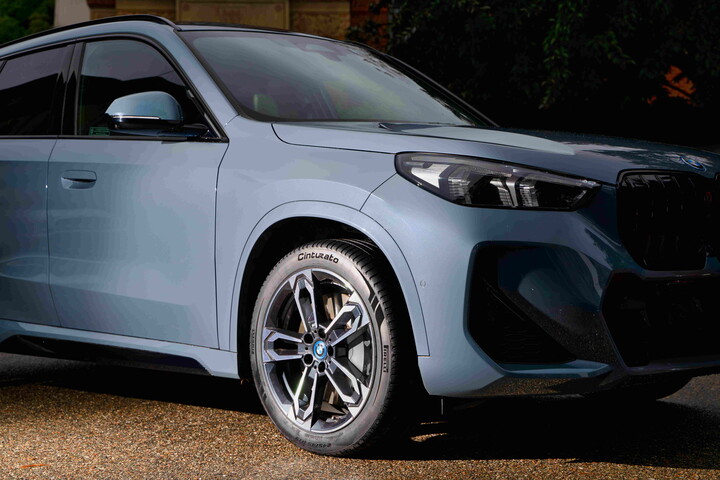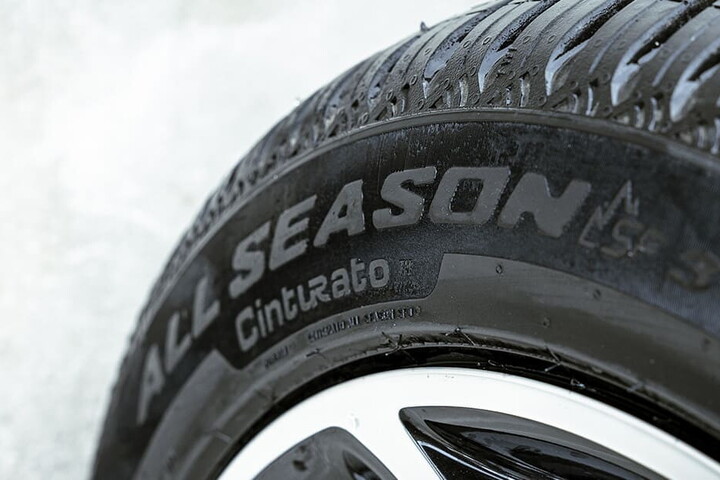A road trip to Europe out of season can be an enchanting idea, perhaps driving in the midst of a landscape covered with snow. But to do so safely for both your passengers and your wallet and to avoid getting fined, you need to be properly equipped with winter tyres marked M+S which comply with the applicable regulations in force in the countries that you expect to drive through, because the rules can change each time you cross a border. You should also note that in Europe, winter tyres, like summer ones, must have a tread that is a minimum of 1.6 mm deep.
Here is an overview of the obligations and prohibitions to keep in mind, country by country. However, before setting off on a journey, we recommend you fully review the laws of each state you intend to visit.
FRANCE
Winter tyres are compulsory in some sections of the road indicated by signs in the presence of certain weather conditions. The obligation to use snow chains, fitted on the driving wheels, can be signaled with short notice in particularly critical conditions, together with a speed limit of 50 km/h. In the event of violation of these rules, your vehicle may be prevented from travelling any further and you could be fined Euro 135.
GERMANY
The use of winter tyres, identified in the country with the M+S and 3PMSF symbols, are compulsory in the event of winter weather and road conditions. The obligation is signaled on some mountain roads when the weather makes it necessary. . The country permits the use of snow chains in exceptional cases and with the application of 50 km/h speed limit. In the event of infringement, the applicable fine ranges from Euro 40 to Euro 80 if your vehicle impedes traffic.
AUSTRIA
The obligation to use winter tyres or chains is applicable in the presence of winter road conditions for all vehicles under 3.5 tonnes, from 1st November to 15th April of the following year. If you ignore this obligation, you could incur a fine of Euro 35, which could go up to Euro 5,000 if you put the safety of other road users at risk. There are areas where access is prohibited, with the exception of vehicles fitted with winter equipment. The obligation to use snow chains, to be fitted on all the wheels of the driving axles, may be indicated by specific signs. Winter tyres must be fitted on all wheels and have a minimum tread of 5 mm in case of conventional construction and 4 mm in case of radial structure, while snow chains, which must be homologated, may be fitted on the driving wheels in the event of ice and snow. All Season tyres are considered to be winter tyres, provided they are marked M+S.
SWITZERLAND
There is no obligation to use winter tyres, but you may be fined if you drive in winter conditions with summer tyres and block traffic or if the tyres are deemed defective. Snow chains may be compulsory on some sections of road indicated by appropriate signs; the fine for the breach of this obligation is of 100 Swiss francs (about Euro 92).
SLOVENIA
The obligation of winter tyres or All Season tyres with a tread of at least 3 mm applies from 15th November to 15th March and in the presence of winter conditions; alternatively, snow chains can be fitted onto summer tyres provided these also have a tread of at least 3 mm. Winter tyres are indentified here with the symbol M+S and also 3PMSF. The fine for offenders is about Euro 120.
DENMARK
In Denmark there is no general legislation with regard to winter tyres, whereas snow chains may be compulsory in the presence of critical road and weather conditions.
FINLAND
All motor vehicles, from 1st December to the last day of February, must be fitted with winter tyres with a tread of at least 3 mm (but a tread of at least 5 mm is recommended), otherwise you could be fined a minimum of Euro 35. The period is extended in Lapland, where the obligation starts in mid-October until the end of April. Snow chains can be fitted onto winter tyres if the current road and weather conditions require it.
NORWAY
There are no obligations to use winter tyres, but those who use them must check that the tread is at least 3 mm thick; those who instead drive cars fitted with summer tyres must be able to mount chains on them in case of snow or ice.
SWEDEN
All vehicles must be fitted with M+S winter tyres with a minimum tread of 3 mm from 1st December to 31st March. If the conditions require it, snow chains can also be fitted. The penalty for those who violate the obligation to use winter tyres is 1200 Swedish krona (about Euro 125).
BELGIUM
There are no general rules in Belgium; the use of snow chains is envisaged in the event of ice or snow on the road surface.
BULGARIA
The compulsory use of winter tyres, bearing the symbols M+S and 3PMSF, in case of winter road conditions is required from November 15 to March 1 and is only valid for cars registered in Bulgaria, while for foreigners their use is highly recommended. Snow chains can be used to a maximum speed of 50 km/h when the conditions require it and may be compulsory if indicated by signs.
CROATIA
If the road and weather conditions require it, on some appropriately signaled sections of road, the obligation to use winter tyres with a tread of at least 4 mm on the driving wheels applies. Violations cost 700 Kuna (about Euro 90). The requirement applies from November 15 to April 15.
ESTONIA
The compulsory use of winter tyres with a tread of at least 3 mm applies from 1st December until 1st March, but may be extended from October to April if weather conditions require it. Snow chains can be fitted for snow-covered roads.
GREECE
There are no obligations regarding winter tyres, but snow chains must be fitted if the roads are covered with snow.
IRELAND
In Ireland, there are no specific requirements for the winter period; snow chains may only be used when the road surface is covered with snow.
ITALY
In Italy, in the period from 15th November to 15th April, it is compulsory to have snow chains on board the vehicle or for the vehicle to be fitted with winter tyres with the M+S marking . The obligation applies to roads outside inhabited centres, while individual municipalities may make them compulsory inside cities. Offences are punishable by fines of between Euro 85 and 338, and they range from Euro 41 to 169 on municipal roads.
LATVIA
Winter tyres with a minimum tread of 4 mm are required from 1st December until 1st March. Snow chains can be used in case of snow on the road.
LITHUANIA
All vehicles must be equipped with winter tyres from 10th November until 1st April with a tread of at least 3mm. Snow chains can be used on snow-covered roads.
LUXEMBOURG
In the presence of winter conditions such as snow, wet snow, frost or ice vehicles must be fitted with tyres marked M+S. Bikes, quads and other light vehicles are exempt from this obligation. Fines start from Euro 49 and can reach Euro 74 if you block traffic. From 1st December to 31st March you can also use studded tyres, with which you can travel at a maximum of 60 km/h on normal roads and at 90 km/h on the motorway. Snow chains can be fitted when there is snow or ice on the road.
NORTHERN MACEDONIA
Winter tyres (with a minimum tread of 4 mm for vehicles under 3.5 tonnes and a minimum of 6 mm for those with four-wheel drive) must be fitted from 15 November to 1 March. Snow chains can be used to a maximum speed of 70 km/h and may be compulsory when indicated by signs or in the presence of critical conditions.
MONTENEGRO
The use of winter tyres, marked M+S, is compulsory with winter weather and road conditions; you may use snow chains if necessary.
THE NETHERLANDS
There are no obligations requiring winter tyres, however the use of snow chains is prohibited when roads are covered with snow.
PORTUGAL
There are no rules requiring winter tyres, snow chains can be used when the roads are covered with snow.
UNITED KINGDOM
Winter tyres are not compulsory. Snow chains and studded tyres are permitted only when they do not damage the road surface, if the asphalt is covered by a layer of snow.
CZECH REPUBLIC
The obligation to use winter tyres with a tread of at least 4 mm in depth and with M+S, M.S. or M&S marking applies: from 1st November to 31st March; in case of ice, snow or temperatures below 4°C; in the presence of the appropriate signs regardless of the weather conditions. Snow chains are not subject to obligations and their use is permitted only in the presence of a layer of snow on the road. The penalties for violating these rules range between 1,500 and 2,500 crowns (approximately Euro 55 to 92).
ROMANIA
If the roads are covered with snow, ice or are in winter conditions, winter tyres are compulsory. If the road surface is covered with snow you can use snow chains; their use is recommended in mountainous regions.
SERBIA
The obligation to fit your vehicle with winter tyres with a tread of at least 4 mm applies from November 15 to March 1, in winter road conditions. You should have snow chains in the boot of your vehicle to fit when necessary.
SLOVAKIA
From November 15 to March 31, all vehicles must be fitted with winter tyres or All Season tyres with a minimum tread of 3mm and snow chains can be used when snow covers the road surface. Fines start from Euro 60.
SPAIN
There are no obligations concerning the use of winter tyres; snow chains can be used with a maximum speed of 50 km/h if there is snow on the road.
TURKEY
Winter tyres, with the M+S marking, are compulsory from 1st December until 1st April. Snow chains can be fitted when the road surface is covered with snow.
HUNGARY
There is no dedicated legislation, but appropriate signs may be put up in the presence of winter weather conditions. The same applies for snow chains: cars that do not have any may be denied entry at customs. When snow chains are fitted, the speed limit is 50 km/h.




